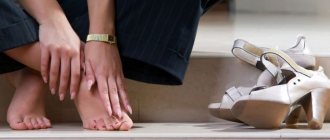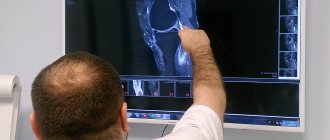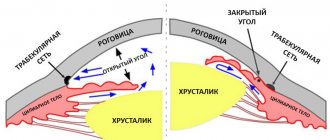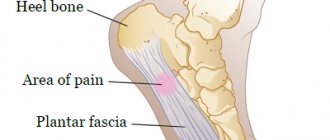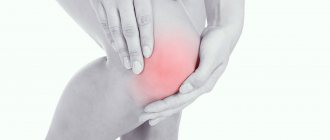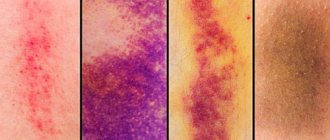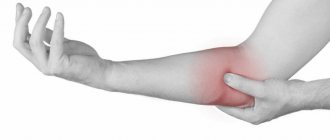Knee joints are joints that are much more susceptible to various mechanical influences than others. The reason for this is their location. Human legs are in motion every day, and carry the weight of not only the body itself, but also the loads that a person carries with him. It is the knee joints that first begin to suffer from diseases such as arthrosis, arthritis, etc. In addition, problems can arise after an injury resulting from overload or strong mechanical impact. Diseases are often discovered after dislocations and fractures. “Pain localized in the front of the knee can be one of the symptoms of many diseases, so for correct treatment it is necessary to visit a doctor who will conduct an examination and identify the problem.”
The leg hurts below the knee, the bone in front: causes
When figuring out why the leg bones below the knee in front hurt, the doctor may suspect the following reasons:
- strong physical stress on the muscles of the lower extremities, which can provoke the appearance of painful convulsive spasms;
- sprains or ruptures of ligaments that occur when performing movements exceeding the amplitude characteristic of the joint;
- any disease of the joint (or part thereof) of an inflammatory or degenerative nature;
- varicose veins, thrombosis;
- injury or bruise received during sports or a fall;
- inflammation of subcutaneous fat;
- violation of water-salt balance;
- radiculitis;
- pregnancy or excess body weight, causing joint damage;
- fracture of the tibia or fibula.
When the leg bone hurts below the knee in front, additional research may be needed to make an accurate diagnosis.
An innovative domestic drug for normalizing metabolic processes in bone tissue and eliminating pain can be purchased in the Parapharm-Shop online store.
Obliterating peripheral artery disease
PADS is a permanent process of narrowing or blockage of the arteries that supply oxygen-rich blood to various organs, including the lower extremities.
The main cause of occlusive lesions of the peripheral vessels of the lower extremities is the accumulation of cholesterol, calcium and other substances on the walls of the arteries (atherosclerosis). The narrowing of the artery lumen leads to a decrease in the supply of arterial blood to the leg muscles, which is especially evident during physical activity. When the muscle is at rest, the blood supply may be adequate.
The main symptom of obliterating disease of the arteries of the legs is pain in the calf muscles, thighs and buttocks, which appear after physical activity (such as climbing a hill or stairs, running, walking). This pain is called intermittent claudication. This usually occurs after a certain amount of movement and disappears after rest. As the disease progresses, symptoms appear with minimal physical activity. In addition to pain, patients are often concerned about: decreased muscle strength in the legs and balance when standing, numbness in one or two legs, and the appearance of ulcers that heal slowly. Treatment is usually conservative. In case of severe disruption of blood supply, surgical treatment methods are indicated.
What examinations should you undergo if you have pain in the leg bones below the knee in front?
Pain in the leg bone below the knee in front should be a reason to contact an orthopedic traumatologist. If necessary, he can refer the patient for consultation to a surgeon, neurologist or other specialist. The examination plan may include:
- a survey to find out under what circumstances pain first appeared, how they are related to external factors, as well as to study the patient’s complaints, information about him and the development of the disease;
- physical diagnostic methods : examination, feeling the diseased limb (palpation), tapping it and analyzing the sounds that arise during this (percussion) - using these methods, the doctor assesses the condition of the area under the knee, finds out whether there is swelling, redness and other deviations from the norm;
- X-ray examination of the lower leg - this method allows you to detect pathologies of the skeletal system: fractures, changes in bone structure, the formation of growths or calcified areas on the surface of the bone and other changes;
- computed and magnetic resonance imaging – highly informative methods of layer-by-layer tissue scanning help to accurately determine the location of the pathological focus, its size and structure, and are used to assess the condition of bone tissue, blood vessels, nerves, and soft tissues;
- ultrasound, Dopplerography, duplex scanning - allow you to study the condition of blood vessels, their blockage or expansion, as well as the speed of blood flow;
- electrophysiological studies : electromyography, electroneurography, electroneuromyography - allow you to assess the degree of damage to the nerve trunk and muscle fibers;
- laboratory diagnostics : analysis of tissues and biological fluids using specialized equipment allows you to assess the severity of inflammatory processes and study the state of the body in autoimmune diseases.
Which specific studies will be prescribed to the patient depends on the results of the doctor’s preliminary conversation with him and the clarity of the clinical picture.
Types of leg amputation in our clinic
Amputation of the lower leg according to Pirogov is an osteoplastic amputation with a good functional result. Our clinic successfully uses this excellent method of amputation for severe gangrene of the foot. This method allows you to preserve the completely supporting stump of the lower leg. In most cases, after 4 months the patient can walk completely freely on the prosthesis without a stick. The heel area is preserved. The photo shows the stump after amputation according to Pirogov. The patient goes fishing and hunting in special shoes.
Amputation of the lower leg at the border of the upper and middle third. Preservation of the knee joint is very important for subsequent rehabilitation. According to our observations, all patients with a healed shin stump stood on the prosthesis and were able to move independently and even work. The technique of leg amputation must be masterful; only in this case can the healing of the stump be guaranteed. After leg amputation, complete social rehabilitation is achieved. Mortality with this operation is significantly lower than with hip amputation. The photo of a lower leg amputation demonstrates the possibility of effective prosthetics.
Pain of pain - discord! Probable diagnoses
If the bone behind the knee in front hurts, the doctor can try to find out the cause by the nature of the pain.
Aching, nagging pain is most often a symptom of a developing inflammatory process in the joint and erosive-destructive lesions of a rheumatoid nature.
Severe, sharp pain occurs when ligaments, tendons are torn, bruised or fractured elements of the knee, acute inflammation of the synovial bursa, exacerbation of degenerative damage to the cartilage lining (meniscus), which acts as a shock absorber in the joint and stabilizes the knee joint, as well as deforming osteoarthritis.
Acute pain in the leg bone below the knee at the front may indicate meniscal damage.
Aches in the lower leg often indicate the development of osteoporosis, a chronic progressive bone disease characterized by increased fragility.
The boring nature of pain in bones and muscles is observed with osteomyelitis, an infectious and inflammatory disease that affects the structural elements of bones. The pain is often accompanied by symptoms such as redness of the skin, swelling, and an increase in body temperature to 38–39 degrees.
Throbbing pain indicates advanced deforming arthrosis or meniscus injury.
Burning pain is characteristic of pinched sciatic nerve (they can reach the toes), as well as bone tuberculosis.
Shooting pain usually occurs when a nerve trunk is pinched.
Dull pain can accompany inflammation of the bursa of the joint, as well as chronic osteochondritis, a disease in which a small section of cartilage is separated from the adjacent bone and is displaced into the cavity of the knee joint.
Why do my shins hurt when I have flat feet?
Flat feet are characterized by an irregular anatomical shape of the foot (flattening of its longitudinal and transverse arch). As a result, the foot ceases to function as an effective spring when walking.
As a result, additional load falls on the muscular-ligamentous apparatus of the lower leg and foot, which become overloaded and quickly tire while walking. Due to muscle fatigue, painful sensations appear in the lower leg, especially in the anterior muscle group. After a short rest, such pain usually goes away quickly. Using comfortable shoes with shock-absorbing soles or orthopedic insoles significantly alleviates pain in the lower legs when walking.
The bone in the leg below the knee in front hurts: how is it treated?
If the cause of discomfort under the knee is an injury - a bruise or a fracture - treatment will be aimed at eliminating the inflammatory process, relieving heat, pain, swelling and redness, as well as healing bone fragments. In the latter case, the bone fragments are first aligned, and then they are fixed in the correct position using various types of bandages until a callus is formed.
In diseases of an infectious nature (bone tuberculosis, osteomyelitis and others), the efforts of doctors are directed towards fighting the pathogen. In this case, you cannot avoid taking antibiotics that are effective against a specific pathogen.
Treatment for pinched sciatic nerves and nerve trunks is aimed at relaxing the muscles and relieving pain. Typically, drugs from the group of centrally acting muscle relaxants, nonsteroidal anti-inflammatory drugs, glucocorticoids, and analgesics are used. Neurotropic vitamins from group B can also be prescribed, which can effectively influence the processes occurring in the nervous system.
In the case of diagnosing vascular pathology, the goal of the therapy used is the correction of disturbances in circulatory function, aimed at improving the health of blood vessels. Usually, drugs from the group of venotonics (phlebotonics) are prescribed, which improve the condition of the vascular wall and normalize blood microcirculation in the affected area.
With increased blood viscosity, antiplatelet agents and anticoagulants are additionally prescribed. The former prevent platelets from sticking together and forming blood clots. The latter make the blood more liquid, facilitating its passage through the vessels. In particularly advanced cases, surgical treatment is resorted to: the dilated vessel is removed (phlebectomy), a special substance is injected into it that glues the vascular walls (sclerosing) or the vessel is sealed using a laser (laser coagulation).
What to do if pain in the leg bone below the knee in front is caused by metabolic disorders?
A common cause of a very unpleasant condition, when the bone on the leg below the knee in front hurts, is a violation of metabolic processes in bone tissue.
Normally, two closely interconnected processes are constantly taking place in bone tissue - the destruction of old sections of bone and the construction of new strong bone structures in the vacated areas.
With age, destructive processes begin to prevail over creative ones. Scientists explain this fact by a deficiency of sex hormones, especially testosterone, which stimulates an increase in the number of building cells and prolongs their life. Bones become loose, cavities form in them, and the risk of fractures increases.
The cavities make it difficult for calcium to be removed from the dismantled areas of the bone into the blood. The mineral enters places not intended for this purpose - the cartilage tissue of the joints, causing its liming and the subsequent development of inflammatory and degenerative processes. Arthritis or arthrosis of the knee joint develops.
Especially for such cases, a unique drug was developed in Russia, which has no analogues in the world - Osteomed Forte . Its creator is Professor, Doctor of Medical Sciences, founder of the Volga Region Osteoporosis Center V.I. Strukov.
The new remedy allows you to influence the very cause of fractures, the development of arthritis and arthrosis - metabolic disorders. Osteomed Forte gently stimulates the production of the body's own sex hormones, activates restoration processes in bone tissue and normalizes metabolic processes.
Research organized by the Penza Institute for Advanced Medical Studies has shown that the use of a new osteoprotector helps close voids in the bones, accelerates the healing of fractures, strengthens bone tissue and eliminates pain.
Osteomed Forte can be purchased in the Parapharm-Shop online store.
Pregnancy
Pain and tenderness in the lower leg (less often in the thigh) can occur during pregnancy. In pregnant women, pain may be accompanied by swelling of the lower leg and thigh (both one and both limbs). The causes of pain in the legs in pregnant women are not entirely clear. On the one hand, this is explained by a violation of the outflow from the venous network of the lower extremities due to the fetus. On the other hand, a decrease in electrolytes in the blood contributes to the appearance of muscle cramps, which serve as one of the sources of pain. Unilateral swelling and pain in the limb may be associated with compression of the iliac artery by an enlarged uterus.
